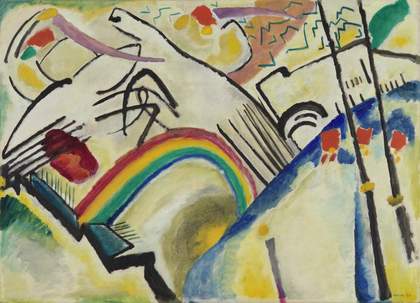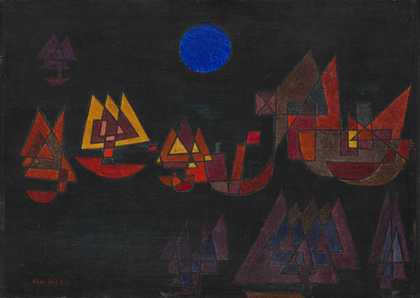
Wassily Kandinsky
Cossacks (1910–1)
Tate
The Blue Rider (Der Blaue Reiter) was an informal collective of modern expressionist artists who came together in Munich, Germany in 1911. Led by artists including Wassily Kandinsky, Gabriele Münter and Franz Marc, the group aimed to explore the emotional and spiritual dimensions of art, emphasising abstraction, symbolism and expressive mark-making. Other members included August Macke, Elisabeth Epstein, Marianne Werefkin, and Alexej Jawlensky. The Blue Rider connected artists, musicians and performers across nations, cultures, media and styles, embracing a plurality of creative approaches. Their statements, texts and images published in The Blue Rider Almanac advocated for the liberation of art from conventional constraints, and for creative expression as a vehicle for transcendent spiritual experiences. The collective's name is said to derive from Kandinsky's 1903 painting The Blue Rider, which symbolises the freedom and journey of the artist's spirit. Through their innovative approach to colour, form, and media, the Blue Rider artists significantly influenced the development of European modern art.
The Blue Rider began with the formation of the NKVM (New Artists’ Association of Munich) in 1909. Progressive for its time, the association admitted women artists such as Marianne Werefkin and Elisabeth Epstein, enabling them to exhibit and sell their work. It also drew in musicians such as Thomas von Hartmann and the free movement performer Alexander Sacharoff. Previously solitary artists such as Paul Klee, Franz Marc and Robert Delaunay established creative bonds with other members of the community from 1911 – the year the Blue Rider was formed.
The Blue Rider artists navigated the economic and critical landscape of 1900s European artistic circles, successfully building their careers. They participated in exhibitions nationally and internationally as well as staging monographic shows. Collaboration with the writer and gallerist Herwarth Walden ensured access to the art market. They built relationships with museum curators, writers and educational theorists while contributing to Walden’s progressive magazine Der Sturm, bringing their ideas to a wider audience.
Collecting folk artworks, cultural objects and popular media was important for the Blue Rider artists as they strived towards the idea of an art ‘that knows no borders’. They were interested in the local crafts and religious artefacts of Bavarian craftspeople, toys and popular prints from Eastern and Central Europe, as well as prints and reverse glass painting from South and East Asia. Objects produced by local and international artists and craftspeople who were not academically trained were perceived by European modernists as ‘unspoiled’ and ‘authentic’. When shown in modernist exhibitions and illustrated in publications these works were often presented anonymously and removed from their original context. They were showcased purely for their stylistic qualities, artistry and boldness of colour. Art historians have since criticised this approach for its reductive presentation of local cultural creative practices.
With the outbreak of the First World War in 1914 the collective dispersed, devastated by the loss of lives and changing personal relationships. Modern artists were also persecuted by the German Nazi party from 1933, with many forced to emigrate elsewhere. Following the Second World War, the Blue Rider works appeared in the first iteration of the Documenta exhibition in Kassel, Germany in 1955. Marking a celebration of complex cultural connections in post-war artistic communities, it also secured the collective’s lasting influence on generations of artists to come.



